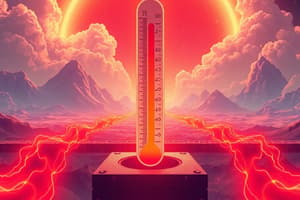Podcast
Questions and Answers
What is the common definition of temperature?
What is the common definition of temperature?
A measure of the hotness or coldness of an object.
Heat and temperature are synonymous.
Heat and temperature are synonymous.
False (B)
What unit is used to express the quantity of heat?
What unit is used to express the quantity of heat?
- Joules (correct)
- Celsius
- Fahrenheit
- Kelvin
What happens to heat when two objects have the same temperature?
What happens to heat when two objects have the same temperature?
What are the three main methods of heat transfer?
What are the three main methods of heat transfer?
In the Celsius temperature scale, the freezing point of water is __ degrees.
In the Celsius temperature scale, the freezing point of water is __ degrees.
In the Kelvin scale, absolute zero is determined to be __ degrees Celsius.
In the Kelvin scale, absolute zero is determined to be __ degrees Celsius.
What do thermal conductors do?
What do thermal conductors do?
What is linear expansion?
What is linear expansion?
What is the equation for volume expansion?
What is the equation for volume expansion?
Flashcards are hidden until you start studying
Study Notes
Temperature vs. Heat
- Heat and temperature are distinct; temperature measures the perceived "hotness" or "coldness" of an object.
- Temperature correlates with the kinetic energy of molecules; higher temperatures indicate greater kinetic energy.
- Thermometers measure temperature and are affected by changes in matter.
Understanding Heat
- Heat is a form of kinetic energy transferred between objects of differing temperatures.
- Heat flows from warmer to cooler objects and is measured in Joules (J).
- No heat transfer occurs at thermal equilibrium (when objects are at the same temperature).
Temperature Measurement Methods
- Temperature can be gauged through:
- Volume changes in solids and liquids.
- Pressure changes in gases.
- Changes in resistivity.
Temperature Scales
- Celsius: Based on the freezing point (0°C) and boiling point (100°C) of water.
- Fahrenheit: Based on freezing point (32°F) and boiling point (212°F) of water; its degree equals 5/9 of Celsius degrees.
- Kelvin: Temperature scale based on gas behavior; absolute zero is at −273.15°C and is expressed in Kelvin (0 K) without a degree sign.
Matter Expansion with Temperature
- Matter expands when temperatures increase; expansion can be linear or volumetric.
- Linear Expansion: ΔL = αL0ΔT, linking change in length (ΔL) to original length (L0) and temperature change (ΔT).
- Volume Expansion: ΔV = βV0ΔT, linking change in volume (ΔV) to original volume (V0) and temperature change (ΔT).
- Coefficients of linear (α) and volume (β) expansion vary by material.
Thermal Conductivity
- Thermal conductors allow heat transfer; thermal insulators impede heat transfer.
Methods of Heat Transfer
- Conduction: Heat transfer via direct contact between materials.
- Convection: Heat transfer through fluid motion (liquids and gases).
- Radiation: Heat transfer through electromagnetic waves.
Studying That Suits You
Use AI to generate personalized quizzes and flashcards to suit your learning preferences.




